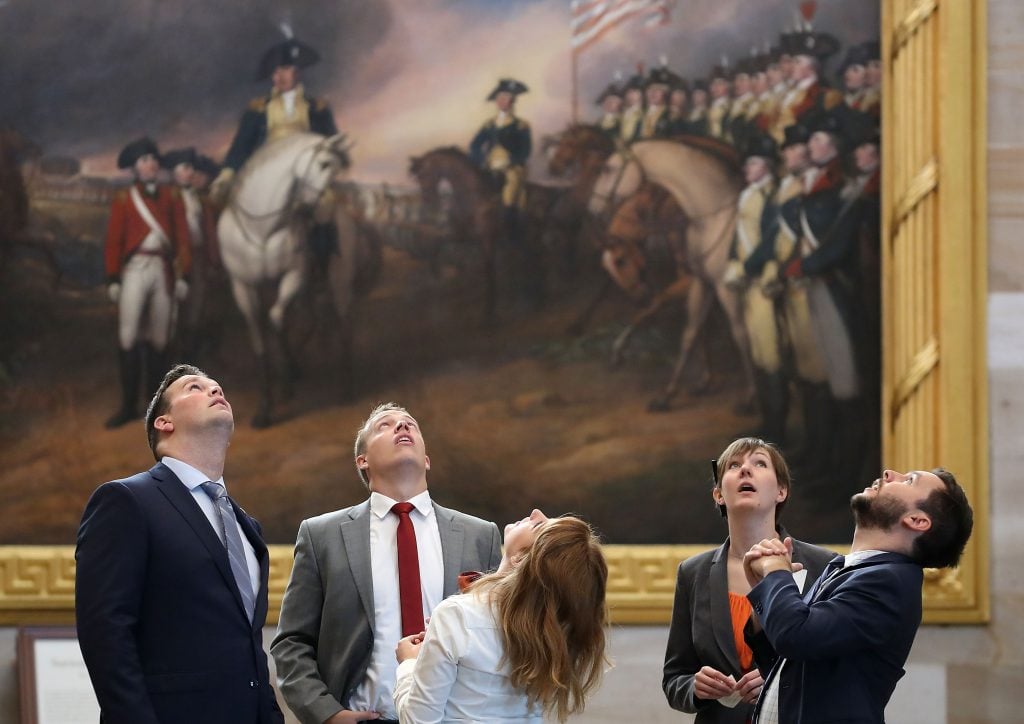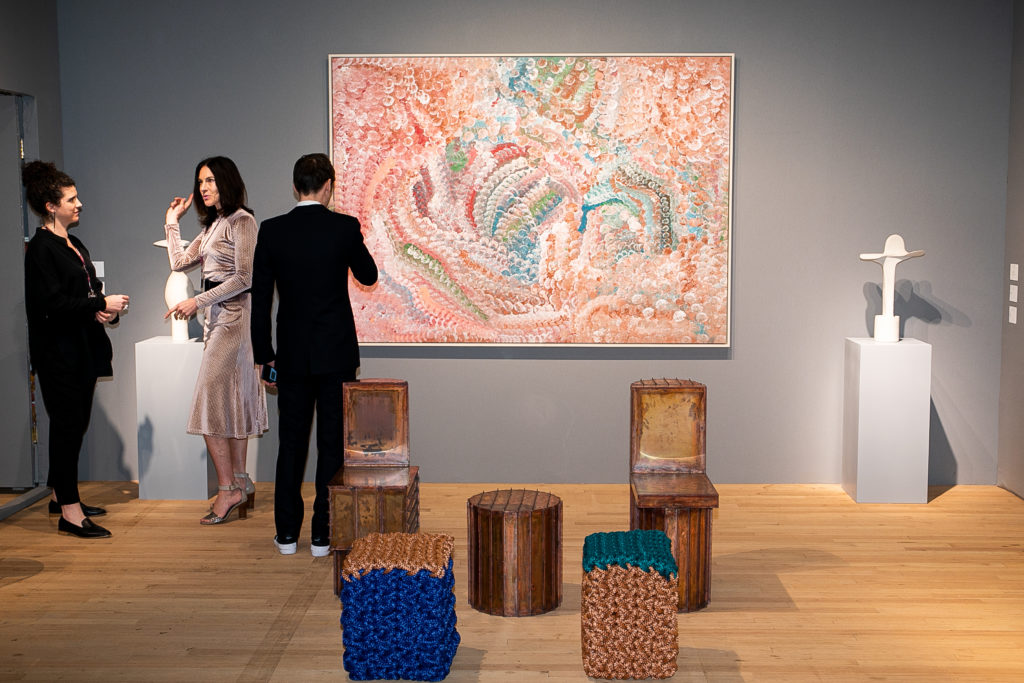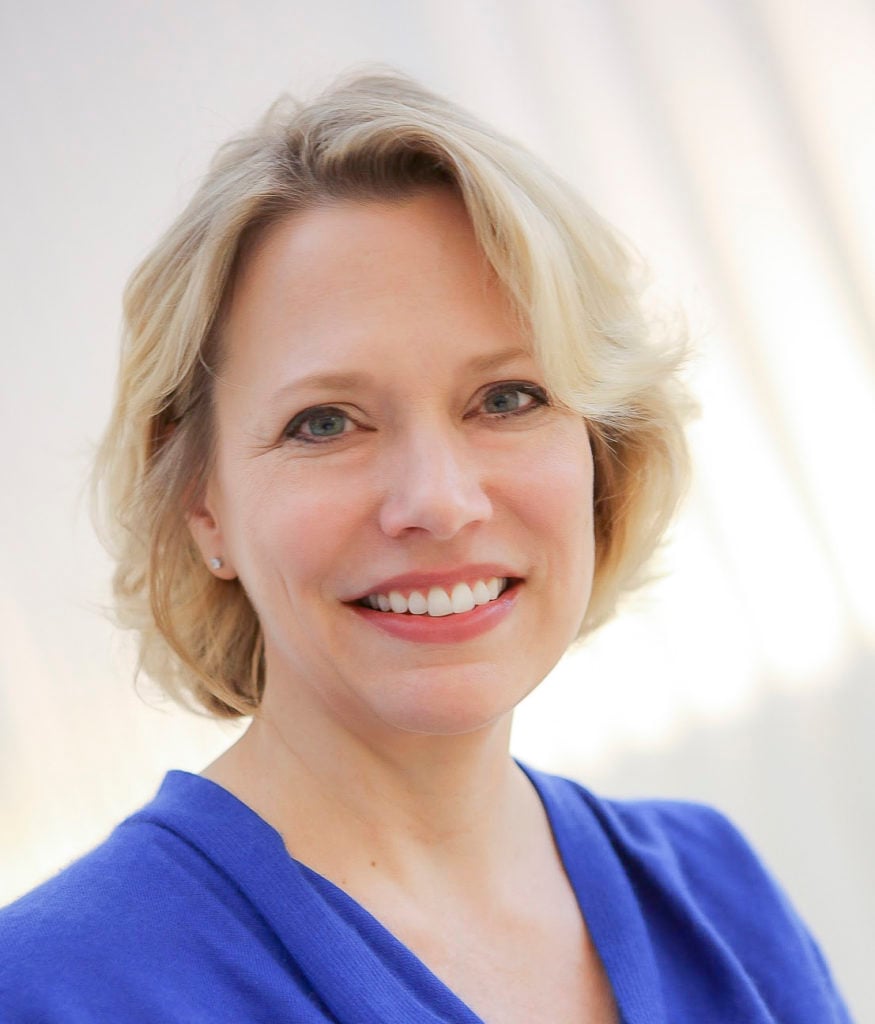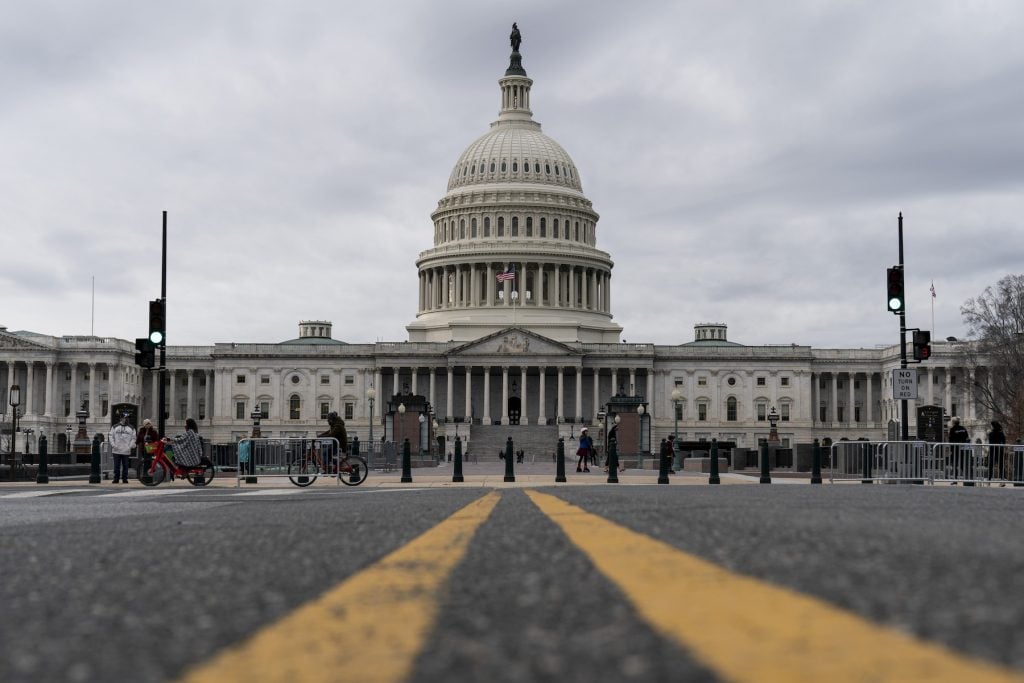Every Wednesday morning, Artnet News brings you The Gray Market. The column decodes important stories from the previous week—and offers unparalleled insight into the inner workings of the art industry in the process.
This column is the conclusion of a two-part series on the art industry’s use of Washington lobbyists. You can find part one here.
This week, switching the focus from payouts to procedures…
TRUST THE PROCESS(?)
American democracy theoretically sustains itself by empowering each citizen with an equal right to organize, vote, and directly communicate with their elected representatives to push for actions they favor—all without ever having to pay for it. Political lobbying, meanwhile, hinges on individuals, organizations, or interest groups influencing policy outcomes by writing checks, usually to professional intermediaries who can provide access and strategic knowledge beyond the reach of the average voter. You have to admit, it’s a weird two-step to have legalized shortly after the founding of the republic!
The importance of D.C. lobbyists has only grown in recent decades thanks to the tandem forces of an increasingly pro-business Supreme Court and an increasingly anti-voter political bloc. This dynamic puts businesses in every U.S. industry, including the arts, into a philosophical bind: Should I safeguard my public image by refusing to play the lobbying game? Or should I accept the dissonant realities of the system I’m a part of by spending to protect my interests on Capitol Hill?
Multiple entities on both the for-profit and nonprofit sides of the art business have opted for the latter, collectively directing almost $2.5 million into lobbying efforts since 2018, as I wrote about last week. Since I’ve already parsed the raw figures and the policy goals outlined in public disclosure documents, I now want to pivot to the inner workings of the paid-advocacy process.
Not surprisingly, this interior view doesn’t just complicate the narrative of big money bastardizing democracy for its own ends; it also reveals both how little Washington officials understand about the machinery of the art industry, and how little the art industry understands about the machinery of Washington.

People look up at the ceiling of the newly restored rotunda inside the US Capitol, September 6, 2016 in Washington, DC. Photo by Mark Wilson/Getty Images.
ANGLES OF APPROACH
Broadly speaking, there are two approaches an organization can take to lobbying: pay an already registered firm to advocate on your behalf, or register with the government and do it yourself. Hiring out tends to be much more popular, including within the arts. To understand why, we first have to understand what lobbying actually entails.
At bottom, lobbyists act as a strategic conduit between a client and the officials tied tightest to the specific policy issue(s) that client cares about. A lobbyist can only influence the development of a policy in a desired direction if they intimately understand the current state of play on Capitol Hill, as well as the current concerns of the people they represent.
This is why the most prominent lobbying firms generally operate offices in Washington; the best way to stay connected on issues of national legislative importance is to keep your antennae up in the nation’s legislative capital. It’s also why many individual lobbyists have substantial resumes working with, or as a part of, branches of government prior to becoming paid political advocates; the more experienced you are in navigating the D.C. ecosystem, the more effective you can be in advancing your client’s agenda to the right people at the right times.
Part of that task involves managing the media narrative about a lobbying client and the policies relevant to them. “In Washington, there is a symbiotic relationship between the media and Congress,” one political operative told me. Lawmakers are much more prone to pounce on breaking news than the “lumbering executive branch,” in the operative’s words, meaning reporters and congressmen are often eager to assist one another with provocative, reactive content. Savvy lobbyists can help their clients by quickly putting them in front of legislators to help shape (or counteract) a developing story that might otherwise damage their cause.
For these services, clients normally pay lobbyists a retainer fee. Firms have been known to adjust the amount from installment to installment (or at least cut back on expenditures) based on their expected activity during the upcoming fiscal year or congressional session. If Congress is scheduled to recess the next quarter, for instance, a client might be able to pay somewhat less. But if a particular issue seems to be reaching a critical juncture in the legislative process, fees could increase.
In select cases, however, organizations serve as their own registered lobbyists. In fact, the third-biggest spender on the art-industry list I compiled last week has been taking the DIY approach for years: the Association of Art Museum Directors (AAMD), which paid an estimated $320,000 worth of lobbying-related fees from 2018 through 2021.
Why would the AAMD act as its own lobbyist? First, the organization’s members, as public institutions, are usually well acquainted with their elected representatives already, including at the congressional level. So they rarely need an outside intermediary to make connections on their behalf, unlike many clients who hire lobbying firms. Second, the AAMD maintains a permanent office in Washington, which provides an operational base for both lobbying and all other priorities handled by its D.C. staff, such as an ongoing project to map museums’ educational and economic connections to their surrounding communities.
At the same time, the AAMD’s main lobbying responsibilities aren’t terribly different from those of an external firm. Its Washington team mainly coordinates meetings so that lawmakers and their aides can hear from museum leaders directly. The AAMD might also brief the directors ahead of time, sit in on these meetings, and offer technical assistance if the conversation descends into minutiae—all duties that fit snugly into the “strategic conduit” framing.
In addition, the association tries to alert specific members whenever their elected representatives take actions that could impact them, either positively or negatively. For example, when a member of Congress introduces a bill that could assist museums in their districts, the AAMD might encourage the directors of those institutions to thank their reps for their advocacy.
The process above illustrates why it’s somewhat misleading to portray the AAMD as paying lobbying fees in the same sense as clients that hire out for those services. The $320,000 reported on the organization’s disclosure forms since 2018 essentially cover staff time, overhead expenses for the Washington office, and transportation to/from Capitol Hill in the pre-COVID era. (Most lobbyist-engineered meetings in 2020 and 2021 migrated to video calls.)
As for the policy matters on the AAMD’s agenda since 2018, public records show that the organization has had its hands full. Disclosure forms identify more than a dozen specific lobbying issues that can be filtered into two categories. The first we can call ongoing concerns, such as implementing, preserving, and/or maximizing a slew of tax deductions related to charitable giving, as well as securing appropriations for the National Endowments for the Arts and Humanities. The second consists of issues made acute by larger sociopolitical events, such as the parameters of national COVID-relief funding and President Biden’s $1 trillion infrastructure bill.
Lobbying tends to be no less multipronged or responsive when an outside firm is behind the wheel. Just consider the Beltway exploits of the Art Dealers Association of America (ADAA).

Visitors browse the gala preview of the ADAA Art Show’s 2020 edition. © BFA. Photography by Jocko Graves / BFA.com. Courtesy of the Art Dealers Association of America.
DEALERS’ CHOICE
As a refresher, the ADAA paid an estimated $450,000 in lobbying fees to the Washington-headquartered law firm WilmerHale from April 2019 through December 2021. Its total bill for those services eclipsed that of all other art-business entities except Sotheby’s (which declined to comment for this story) since 2018. Retracing the steps of the ADAA’s lobbying odyssey is eye-opening on multiple levels.
The association’s point man at WilmerHale has been Jonathan Yarowsky, co-chair of the firm’s public policy and legislative affairs practice. In a joint interview with ADAA executive director Maureen Bray, Yarowsky described himself as “an antitrust attorney by trade,” who worked as a congressional counsel for 12 years before being appointed special counsel to former President Bill Clinton. In 1998, he moved into private practice, where lobbying became one aspect of his responsibilities.
Like many of his peers, Yarowsky is wary of the negative connotations associated with lobbying. He opened his answer to my first question about his role by stressing that he “feels more like an advocate” than a lobbyist.
“In Washington, often your law practice interfaces with government. I use the word ‘lobbying’ when I go before Congress, but when I appear before the Supreme Court, I’m doing the same kind of advocating,” he said.
When I asked Yarowsky for a summary of what his advocacy for the ADAA has entailed day to day, he described the firm’s main service as being “out there picking up currents, able to design an outreach strategy so that people on all sides of the aisle understand what’s important to Maureen and her group, and who they are. Because who they are makes a big difference on the policies that might be imposed.”
Bray elaborated on this concept through the lens of one of the ADAA’s chief lobbying concerns, the potential for sweeping reforms to the Bank Secrecy Act and Anti-Money Laundering Act that could have placed stringent new regulatory requirements on art dealers.
Momentum began gathering around this prospect in Washington in late 2018, shortly after Bray started in her current position. It quickly became an urgent priority among the ADAA’s nearly 190 members, all of which are small businesses, and the “vast majority” of which have 10 or fewer employees, according to Bray.
“Compliance for a large bank is very different from compliance for a gallery with three full-time staff and a part-time accountant. It was important for us to make sure folks on the Hill understood what our membership looked like,” Bray said.
Thanks to a recommendation from an ADAA member, Bray connected with WilmerHale and Yarowsky. In practice, their partnership played out through regular (usually weekly) meetings where the two traded information about the latest relevant developments, respectively, in the art industry and on Capitol Hill, then plotted out the next set of meetings to book with specific lawmakers as part of an ongoing advocacy plan.
The strategy demanded walking a series of political tightropes, starting with the one between red and blue legislators. “Staff on both sides of the aisle talk to each other,” Yarowsky said. If the ADAA were primarily meeting with Democrats, their Republican counterparts would inevitably find out—and their displeasure about the discrepancy could encumber the organization’s entire agenda.

ADAA executive director Maureen Bray. Photo: Victor A. Mirontschuk, courtesy of the ADAA.
The same was true for maintaining equilibrium between the houses of Congress, as well as jurisdictional committees responsible for the two regulatory acts. The relevant bills were being overseen by the House Banking Committee and Senate Banking Committee, meaning lawmakers with seats on those bodies were of outsize importance, particularly early in the process.
What quickly became clear in these meetings, Bray said, was that there “wasn’t a lot of nuanced understanding of the different parts of the art market” on Capitol Hill. The confusion came partly from the paucity of empirical data on anti-money laundering in the industry. So Bray and, in some cases, ADAA members tried to enlighten lawmakers about the finer points—for instance, that auction houses and commercial galleries control very different market shares, face very different pressure points, and have very different staffing and resources.
The campaign was working well, according to Bray and Yarowsky. Then, in March 2020, COVID hit. In Congress and in the gallery sector, attention swiveled to how to keep small businesses safe and solvent during a crisis unlike any in living memory.
As the ADAA’s conduit to Washington, Yarowsky had to start tuning into an additional frequency. While hearings about regulatory reforms continued on Capitol Hill, he and the ADAA spent a significant portion of their working relationship over the next two years on the various pandemic policies and relief programs available to dealers, such as the Paycheck Protection Program and the moratoriums on commercial evictions.
Yet there is no indication of this expanded mandate on the disclosure forms about WilmerHale’s lobbying on behalf of the ADAA. Bank Secrecy Act reform is the only specific lobbying issue mentioned in their quarterly filings. Why?
Because lobbyists are only required to disclose the subjects that they are actively and directly reaching out to Congress members and their staff to discuss on a client’s behalf. Since WilmerHale’s research and analysis into federal COVID policy never crossed the threshold from ADAA-requested education into ADAA-requested advocacy, the firm had no need to call out the shift in its disclosure filings.
This fact reinforces that public records alone don’t always tell the full tale of what lobbyists and their clients are doing in Washington. It’s up to every reader to decide whether to interpret this nuance as reason to give art-industry lobbying clients the benefit of the doubt, or to view the practice with greater skepticism than before.
Regardless, WilmerHale and the ADAA largely appear to have gotten what they wanted from Capitol Hill. A report from the U.S. Treasury earlier this month concluded that the art market required no immediate regulatory changes, and the overwhelming majority of galleries managed to weather the worst challenges of COVID without capsizing.
It’s impossible to quantify how necessary lobbying was to these results. Still, the ADAA’s process acts as a kind of photo negative that captures the risks in trusting Washington officials to do their own research and reach their own conclusions on arts policy, as well as in leaving art businesses to wander through the labyrinth of federal legislation unaided. As a citizen, I would much prefer a democratic system without paid political advocacy. As a pragmatist, though, I think nonprofit and for-profit art professionals must recognize that the system is working as designed—and lobbying will be one of its levers for the long run.
That’s all for this week. ‘Til next time, remember: if you’re not covering every available angle, there’s no telling which way the dice might roll.









